Organisational Behaviour Report: A M HOLDINGS Analysis
VerifiedAdded on 2020/12/29
|22
|6297
|217
Report
AI Summary
This report examines organisational behaviour within the context of A M HOLDINGS, a UK-based SME specializing in packaging and containers. It delves into the company's organizational culture, power dynamics, and political landscape, analyzing their impact on team behavior and individual performance. The report further explores motivational theories, including content and process theories, as applied by A M HOLDINGS to encourage employee task accomplishment. It also outlines the company's approach to team development, referencing the Tuckman model's stages of forming, storming, norming, and performing. The report includes an in-depth analysis of power, culture, and politics, and their influence on team behavior and individual outcomes. Additionally, the report explores the content and process theories of motivation, providing a comprehensive understanding of the factors that drive employee performance within the organization. Finally, it offers insights into the philosophies and concepts of organizational behaviour adopted by A M HOLDINGS.
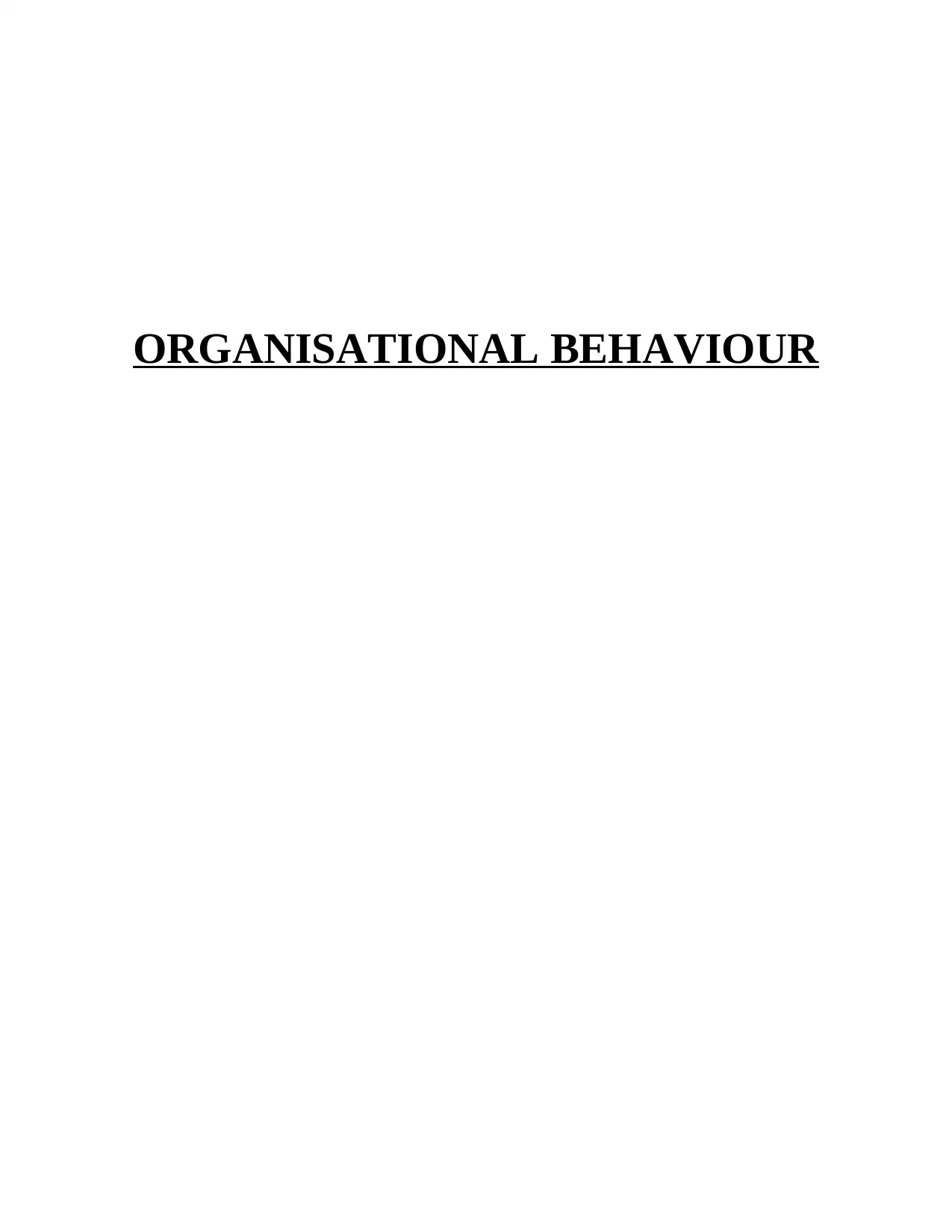
ORGANISATIONAL BEHAVIOUR
Paraphrase This Document
Need a fresh take? Get an instant paraphrase of this document with our AI Paraphraser
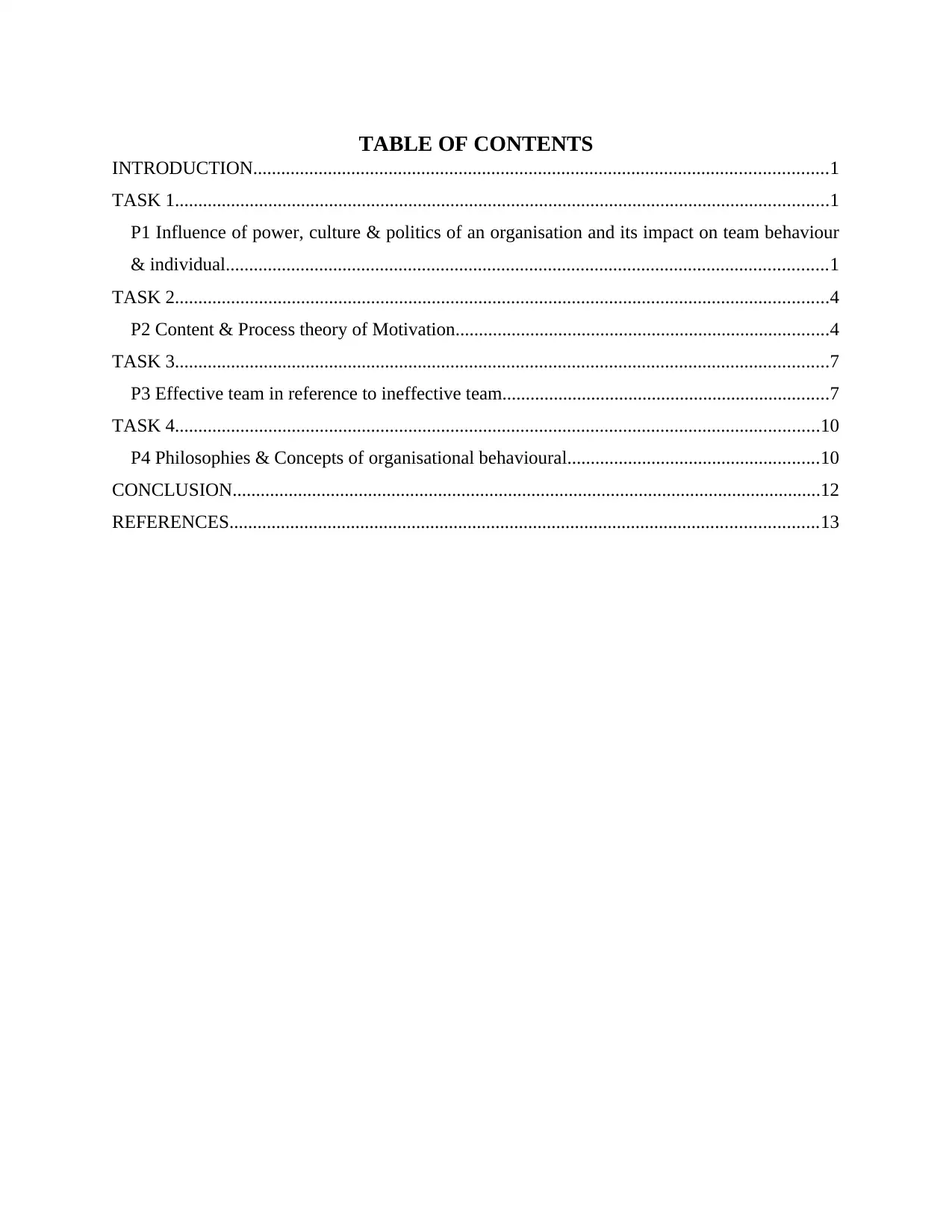
TABLE OF CONTENTS
INTRODUCTION...........................................................................................................................1
TASK 1............................................................................................................................................1
P1 Influence of power, culture & politics of an organisation and its impact on team behaviour
& individual.................................................................................................................................1
TASK 2............................................................................................................................................4
P2 Content & Process theory of Motivation................................................................................4
TASK 3............................................................................................................................................7
P3 Effective team in reference to ineffective team......................................................................7
TASK 4..........................................................................................................................................10
P4 Philosophies & Concepts of organisational behavioural......................................................10
CONCLUSION..............................................................................................................................12
REFERENCES..............................................................................................................................13
INTRODUCTION...........................................................................................................................1
TASK 1............................................................................................................................................1
P1 Influence of power, culture & politics of an organisation and its impact on team behaviour
& individual.................................................................................................................................1
TASK 2............................................................................................................................................4
P2 Content & Process theory of Motivation................................................................................4
TASK 3............................................................................................................................................7
P3 Effective team in reference to ineffective team......................................................................7
TASK 4..........................................................................................................................................10
P4 Philosophies & Concepts of organisational behavioural......................................................10
CONCLUSION..............................................................................................................................12
REFERENCES..............................................................................................................................13
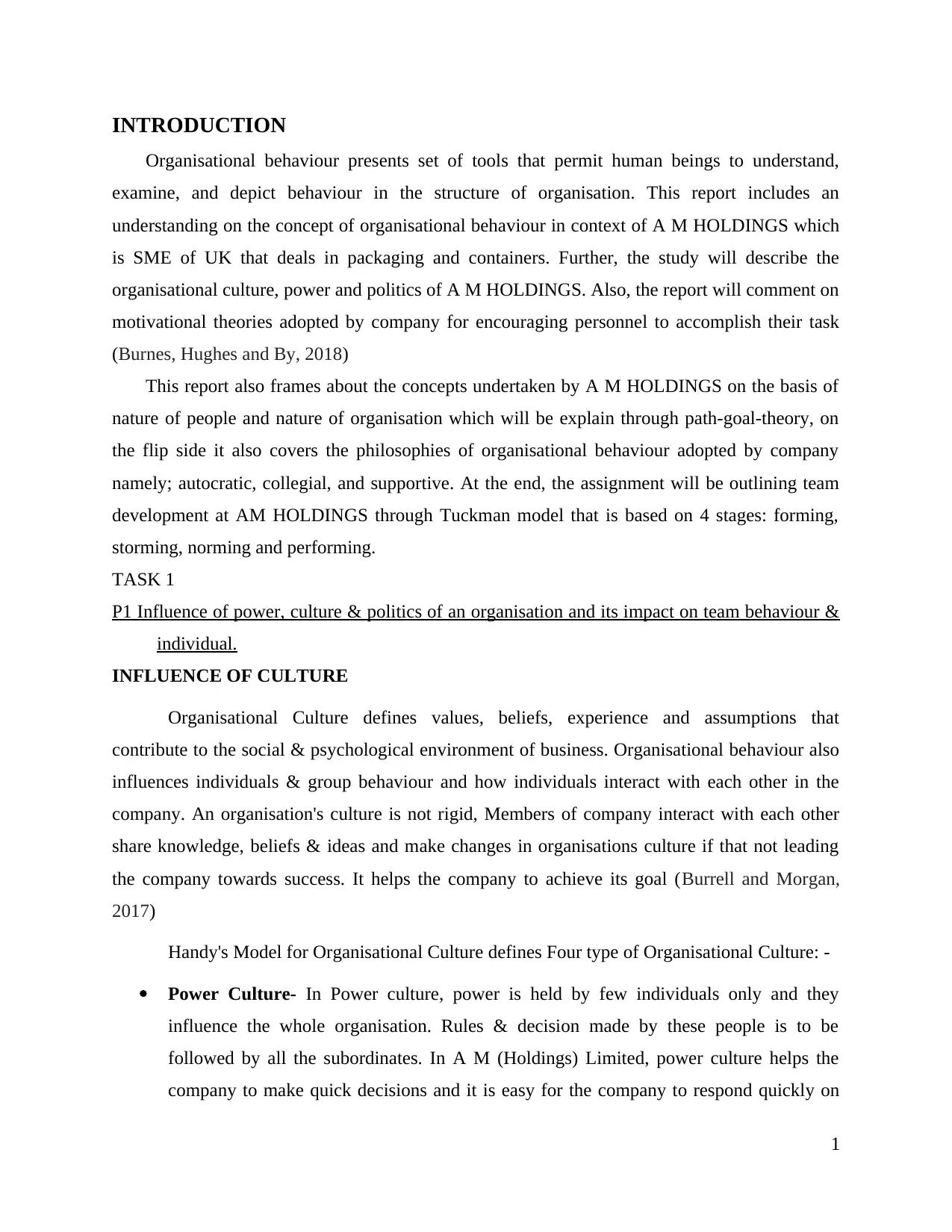
INTRODUCTION
Organisational behaviour presents set of tools that permit human beings to understand,
examine, and depict behaviour in the structure of organisation. This report includes an
understanding on the concept of organisational behaviour in context of A M HOLDINGS which
is SME of UK that deals in packaging and containers. Further, the study will describe the
organisational culture, power and politics of A M HOLDINGS. Also, the report will comment on
motivational theories adopted by company for encouraging personnel to accomplish their task
(Burnes, Hughes and By, 2018)
This report also frames about the concepts undertaken by A M HOLDINGS on the basis of
nature of people and nature of organisation which will be explain through path-goal-theory, on
the flip side it also covers the philosophies of organisational behaviour adopted by company
namely; autocratic, collegial, and supportive. At the end, the assignment will be outlining team
development at AM HOLDINGS through Tuckman model that is based on 4 stages: forming,
storming, norming and performing.
TASK 1
P1 Influence of power, culture & politics of an organisation and its impact on team behaviour &
individual.
INFLUENCE OF CULTURE
Organisational Culture defines values, beliefs, experience and assumptions that
contribute to the social & psychological environment of business. Organisational behaviour also
influences individuals & group behaviour and how individuals interact with each other in the
company. An organisation's culture is not rigid, Members of company interact with each other
share knowledge, beliefs & ideas and make changes in organisations culture if that not leading
the company towards success. It helps the company to achieve its goal (Burrell and Morgan,
2017)
Handy's Model for Organisational Culture defines Four type of Organisational Culture: -
Power Culture- In Power culture, power is held by few individuals only and they
influence the whole organisation. Rules & decision made by these people is to be
followed by all the subordinates. In A M (Holdings) Limited, power culture helps the
company to make quick decisions and it is easy for the company to respond quickly on
1
Organisational behaviour presents set of tools that permit human beings to understand,
examine, and depict behaviour in the structure of organisation. This report includes an
understanding on the concept of organisational behaviour in context of A M HOLDINGS which
is SME of UK that deals in packaging and containers. Further, the study will describe the
organisational culture, power and politics of A M HOLDINGS. Also, the report will comment on
motivational theories adopted by company for encouraging personnel to accomplish their task
(Burnes, Hughes and By, 2018)
This report also frames about the concepts undertaken by A M HOLDINGS on the basis of
nature of people and nature of organisation which will be explain through path-goal-theory, on
the flip side it also covers the philosophies of organisational behaviour adopted by company
namely; autocratic, collegial, and supportive. At the end, the assignment will be outlining team
development at AM HOLDINGS through Tuckman model that is based on 4 stages: forming,
storming, norming and performing.
TASK 1
P1 Influence of power, culture & politics of an organisation and its impact on team behaviour &
individual.
INFLUENCE OF CULTURE
Organisational Culture defines values, beliefs, experience and assumptions that
contribute to the social & psychological environment of business. Organisational behaviour also
influences individuals & group behaviour and how individuals interact with each other in the
company. An organisation's culture is not rigid, Members of company interact with each other
share knowledge, beliefs & ideas and make changes in organisations culture if that not leading
the company towards success. It helps the company to achieve its goal (Burrell and Morgan,
2017)
Handy's Model for Organisational Culture defines Four type of Organisational Culture: -
Power Culture- In Power culture, power is held by few individuals only and they
influence the whole organisation. Rules & decision made by these people is to be
followed by all the subordinates. In A M (Holdings) Limited, power culture helps the
company to make quick decisions and it is easy for the company to respond quickly on
1
⊘ This is a preview!⊘
Do you want full access?
Subscribe today to unlock all pages.

Trusted by 1+ million students worldwide
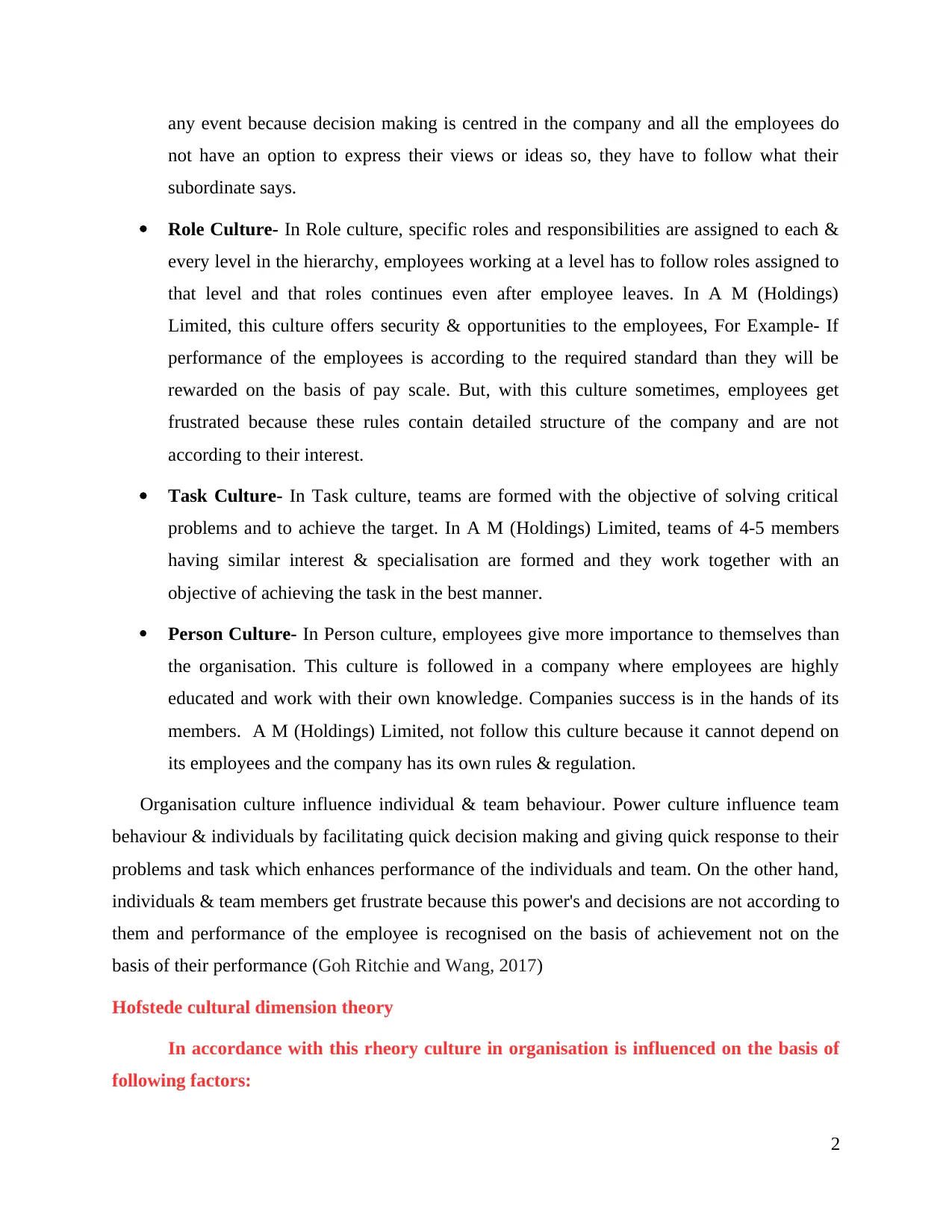
any event because decision making is centred in the company and all the employees do
not have an option to express their views or ideas so, they have to follow what their
subordinate says.
Role Culture- In Role culture, specific roles and responsibilities are assigned to each &
every level in the hierarchy, employees working at a level has to follow roles assigned to
that level and that roles continues even after employee leaves. In A M (Holdings)
Limited, this culture offers security & opportunities to the employees, For Example- If
performance of the employees is according to the required standard than they will be
rewarded on the basis of pay scale. But, with this culture sometimes, employees get
frustrated because these rules contain detailed structure of the company and are not
according to their interest.
Task Culture- In Task culture, teams are formed with the objective of solving critical
problems and to achieve the target. In A M (Holdings) Limited, teams of 4-5 members
having similar interest & specialisation are formed and they work together with an
objective of achieving the task in the best manner.
Person Culture- In Person culture, employees give more importance to themselves than
the organisation. This culture is followed in a company where employees are highly
educated and work with their own knowledge. Companies success is in the hands of its
members. A M (Holdings) Limited, not follow this culture because it cannot depend on
its employees and the company has its own rules & regulation.
Organisation culture influence individual & team behaviour. Power culture influence team
behaviour & individuals by facilitating quick decision making and giving quick response to their
problems and task which enhances performance of the individuals and team. On the other hand,
individuals & team members get frustrate because this power's and decisions are not according to
them and performance of the employee is recognised on the basis of achievement not on the
basis of their performance (Goh Ritchie and Wang, 2017)
Hofstede cultural dimension theory
In accordance with this rheory culture in organisation is influenced on the basis of
following factors:
2
not have an option to express their views or ideas so, they have to follow what their
subordinate says.
Role Culture- In Role culture, specific roles and responsibilities are assigned to each &
every level in the hierarchy, employees working at a level has to follow roles assigned to
that level and that roles continues even after employee leaves. In A M (Holdings)
Limited, this culture offers security & opportunities to the employees, For Example- If
performance of the employees is according to the required standard than they will be
rewarded on the basis of pay scale. But, with this culture sometimes, employees get
frustrated because these rules contain detailed structure of the company and are not
according to their interest.
Task Culture- In Task culture, teams are formed with the objective of solving critical
problems and to achieve the target. In A M (Holdings) Limited, teams of 4-5 members
having similar interest & specialisation are formed and they work together with an
objective of achieving the task in the best manner.
Person Culture- In Person culture, employees give more importance to themselves than
the organisation. This culture is followed in a company where employees are highly
educated and work with their own knowledge. Companies success is in the hands of its
members. A M (Holdings) Limited, not follow this culture because it cannot depend on
its employees and the company has its own rules & regulation.
Organisation culture influence individual & team behaviour. Power culture influence team
behaviour & individuals by facilitating quick decision making and giving quick response to their
problems and task which enhances performance of the individuals and team. On the other hand,
individuals & team members get frustrate because this power's and decisions are not according to
them and performance of the employee is recognised on the basis of achievement not on the
basis of their performance (Goh Ritchie and Wang, 2017)
Hofstede cultural dimension theory
In accordance with this rheory culture in organisation is influenced on the basis of
following factors:
2
Paraphrase This Document
Need a fresh take? Get an instant paraphrase of this document with our AI Paraphraser
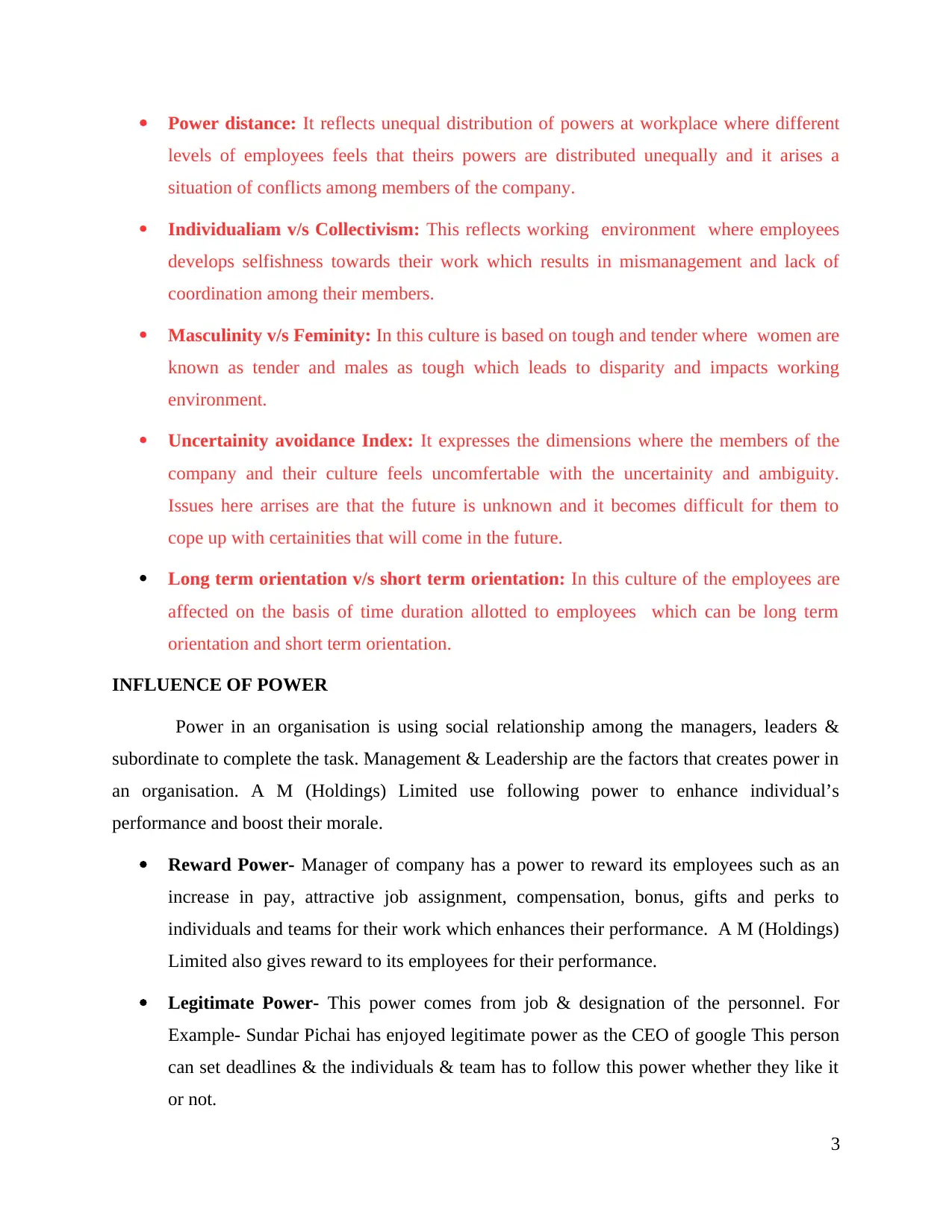
Power distance: It reflects unequal distribution of powers at workplace where different
levels of employees feels that theirs powers are distributed unequally and it arises a
situation of conflicts among members of the company.
Individualiam v/s Collectivism: This reflects working environment where employees
develops selfishness towards their work which results in mismanagement and lack of
coordination among their members.
Masculinity v/s Feminity: In this culture is based on tough and tender where women are
known as tender and males as tough which leads to disparity and impacts working
environment.
Uncertainity avoidance Index: It expresses the dimensions where the members of the
company and their culture feels uncomfertable with the uncertainity and ambiguity.
Issues here arrises are that the future is unknown and it becomes difficult for them to
cope up with certainities that will come in the future.
Long term orientation v/s short term orientation: In this culture of the employees are
affected on the basis of time duration allotted to employees which can be long term
orientation and short term orientation.
INFLUENCE OF POWER
Power in an organisation is using social relationship among the managers, leaders &
subordinate to complete the task. Management & Leadership are the factors that creates power in
an organisation. A M (Holdings) Limited use following power to enhance individual’s
performance and boost their morale.
Reward Power- Manager of company has a power to reward its employees such as an
increase in pay, attractive job assignment, compensation, bonus, gifts and perks to
individuals and teams for their work which enhances their performance. A M (Holdings)
Limited also gives reward to its employees for their performance.
Legitimate Power- This power comes from job & designation of the personnel. For
Example- Sundar Pichai has enjoyed legitimate power as the CEO of google This person
can set deadlines & the individuals & team has to follow this power whether they like it
or not.
3
levels of employees feels that theirs powers are distributed unequally and it arises a
situation of conflicts among members of the company.
Individualiam v/s Collectivism: This reflects working environment where employees
develops selfishness towards their work which results in mismanagement and lack of
coordination among their members.
Masculinity v/s Feminity: In this culture is based on tough and tender where women are
known as tender and males as tough which leads to disparity and impacts working
environment.
Uncertainity avoidance Index: It expresses the dimensions where the members of the
company and their culture feels uncomfertable with the uncertainity and ambiguity.
Issues here arrises are that the future is unknown and it becomes difficult for them to
cope up with certainities that will come in the future.
Long term orientation v/s short term orientation: In this culture of the employees are
affected on the basis of time duration allotted to employees which can be long term
orientation and short term orientation.
INFLUENCE OF POWER
Power in an organisation is using social relationship among the managers, leaders &
subordinate to complete the task. Management & Leadership are the factors that creates power in
an organisation. A M (Holdings) Limited use following power to enhance individual’s
performance and boost their morale.
Reward Power- Manager of company has a power to reward its employees such as an
increase in pay, attractive job assignment, compensation, bonus, gifts and perks to
individuals and teams for their work which enhances their performance. A M (Holdings)
Limited also gives reward to its employees for their performance.
Legitimate Power- This power comes from job & designation of the personnel. For
Example- Sundar Pichai has enjoyed legitimate power as the CEO of google This person
can set deadlines & the individuals & team has to follow this power whether they like it
or not.
3
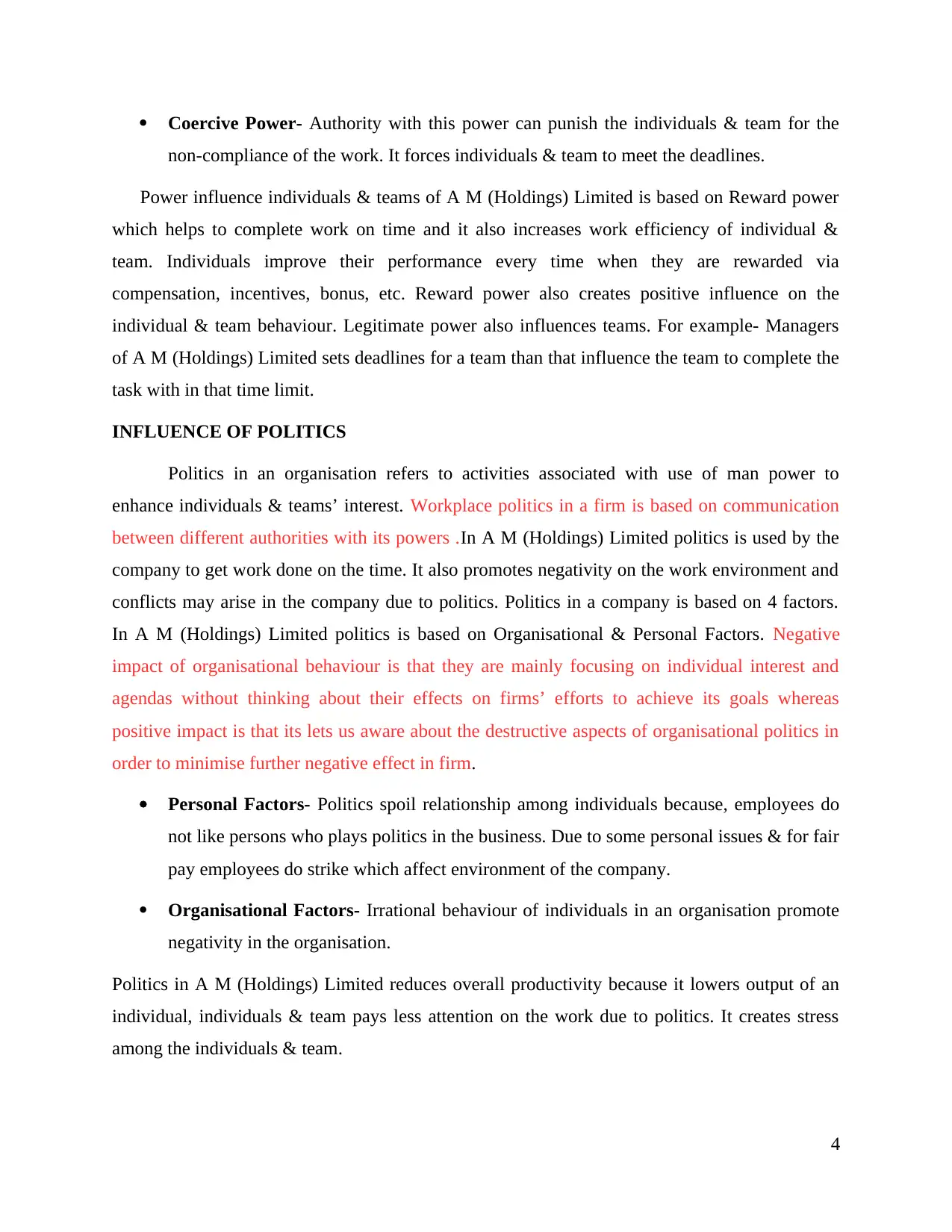
Coercive Power- Authority with this power can punish the individuals & team for the
non-compliance of the work. It forces individuals & team to meet the deadlines.
Power influence individuals & teams of A M (Holdings) Limited is based on Reward power
which helps to complete work on time and it also increases work efficiency of individual &
team. Individuals improve their performance every time when they are rewarded via
compensation, incentives, bonus, etc. Reward power also creates positive influence on the
individual & team behaviour. Legitimate power also influences teams. For example- Managers
of A M (Holdings) Limited sets deadlines for a team than that influence the team to complete the
task with in that time limit.
INFLUENCE OF POLITICS
Politics in an organisation refers to activities associated with use of man power to
enhance individuals & teams’ interest. Workplace politics in a firm is based on communication
between different authorities with its powers .In A M (Holdings) Limited politics is used by the
company to get work done on the time. It also promotes negativity on the work environment and
conflicts may arise in the company due to politics. Politics in a company is based on 4 factors.
In A M (Holdings) Limited politics is based on Organisational & Personal Factors. Negative
impact of organisational behaviour is that they are mainly focusing on individual interest and
agendas without thinking about their effects on firms’ efforts to achieve its goals whereas
positive impact is that its lets us aware about the destructive aspects of organisational politics in
order to minimise further negative effect in firm.
Personal Factors- Politics spoil relationship among individuals because, employees do
not like persons who plays politics in the business. Due to some personal issues & for fair
pay employees do strike which affect environment of the company.
Organisational Factors- Irrational behaviour of individuals in an organisation promote
negativity in the organisation.
Politics in A M (Holdings) Limited reduces overall productivity because it lowers output of an
individual, individuals & team pays less attention on the work due to politics. It creates stress
among the individuals & team.
4
non-compliance of the work. It forces individuals & team to meet the deadlines.
Power influence individuals & teams of A M (Holdings) Limited is based on Reward power
which helps to complete work on time and it also increases work efficiency of individual &
team. Individuals improve their performance every time when they are rewarded via
compensation, incentives, bonus, etc. Reward power also creates positive influence on the
individual & team behaviour. Legitimate power also influences teams. For example- Managers
of A M (Holdings) Limited sets deadlines for a team than that influence the team to complete the
task with in that time limit.
INFLUENCE OF POLITICS
Politics in an organisation refers to activities associated with use of man power to
enhance individuals & teams’ interest. Workplace politics in a firm is based on communication
between different authorities with its powers .In A M (Holdings) Limited politics is used by the
company to get work done on the time. It also promotes negativity on the work environment and
conflicts may arise in the company due to politics. Politics in a company is based on 4 factors.
In A M (Holdings) Limited politics is based on Organisational & Personal Factors. Negative
impact of organisational behaviour is that they are mainly focusing on individual interest and
agendas without thinking about their effects on firms’ efforts to achieve its goals whereas
positive impact is that its lets us aware about the destructive aspects of organisational politics in
order to minimise further negative effect in firm.
Personal Factors- Politics spoil relationship among individuals because, employees do
not like persons who plays politics in the business. Due to some personal issues & for fair
pay employees do strike which affect environment of the company.
Organisational Factors- Irrational behaviour of individuals in an organisation promote
negativity in the organisation.
Politics in A M (Holdings) Limited reduces overall productivity because it lowers output of an
individual, individuals & team pays less attention on the work due to politics. It creates stress
among the individuals & team.
4
⊘ This is a preview!⊘
Do you want full access?
Subscribe today to unlock all pages.

Trusted by 1+ million students worldwide
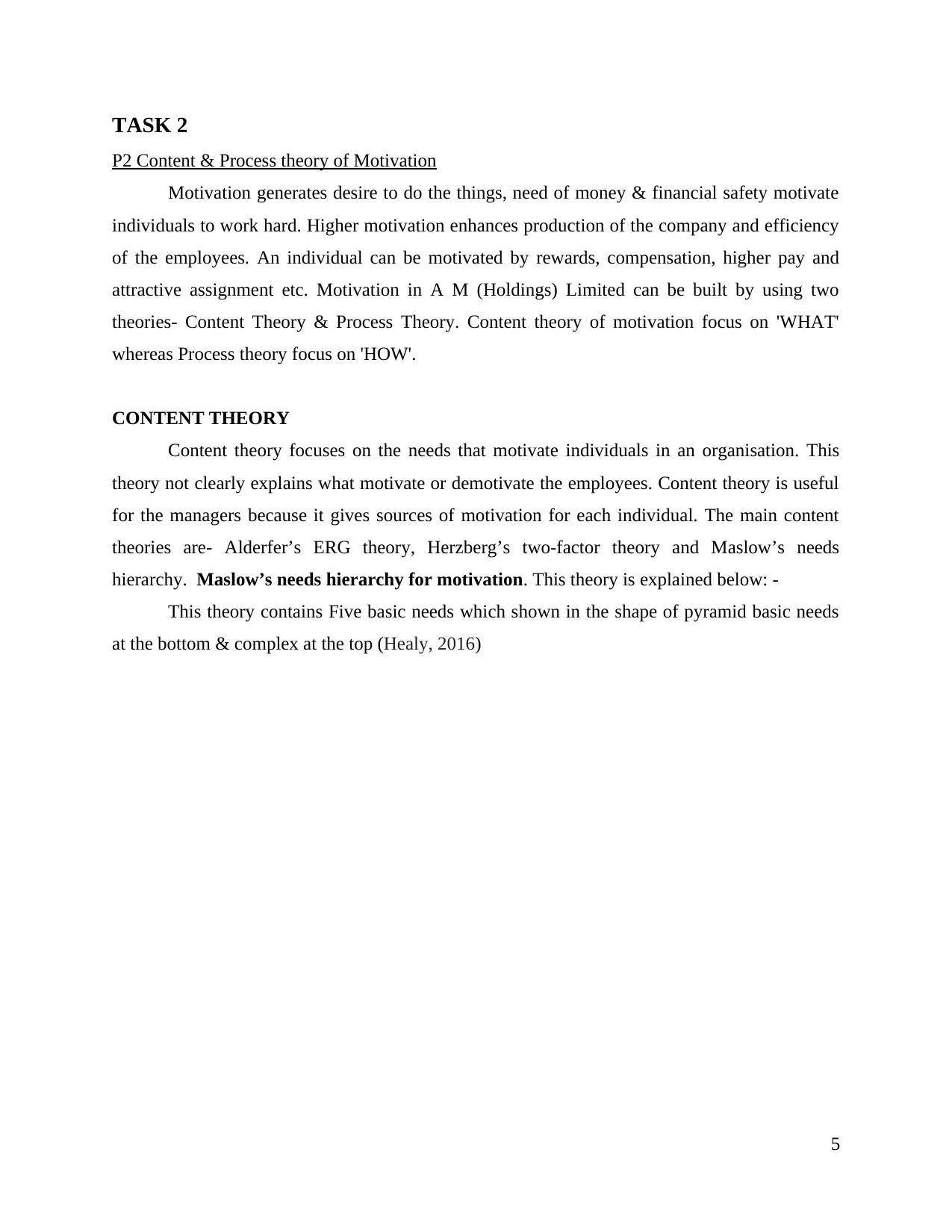
TASK 2
P2 Content & Process theory of Motivation
Motivation generates desire to do the things, need of money & financial safety motivate
individuals to work hard. Higher motivation enhances production of the company and efficiency
of the employees. An individual can be motivated by rewards, compensation, higher pay and
attractive assignment etc. Motivation in A M (Holdings) Limited can be built by using two
theories- Content Theory & Process Theory. Content theory of motivation focus on 'WHAT'
whereas Process theory focus on 'HOW'.
CONTENT THEORY
Content theory focuses on the needs that motivate individuals in an organisation. This
theory not clearly explains what motivate or demotivate the employees. Content theory is useful
for the managers because it gives sources of motivation for each individual. The main content
theories are- Alderfer’s ERG theory, Herzberg’s two-factor theory and Maslow’s needs
hierarchy. Maslow’s needs hierarchy for motivation. This theory is explained below: -
This theory contains Five basic needs which shown in the shape of pyramid basic needs
at the bottom & complex at the top (Healy, 2016)
5
P2 Content & Process theory of Motivation
Motivation generates desire to do the things, need of money & financial safety motivate
individuals to work hard. Higher motivation enhances production of the company and efficiency
of the employees. An individual can be motivated by rewards, compensation, higher pay and
attractive assignment etc. Motivation in A M (Holdings) Limited can be built by using two
theories- Content Theory & Process Theory. Content theory of motivation focus on 'WHAT'
whereas Process theory focus on 'HOW'.
CONTENT THEORY
Content theory focuses on the needs that motivate individuals in an organisation. This
theory not clearly explains what motivate or demotivate the employees. Content theory is useful
for the managers because it gives sources of motivation for each individual. The main content
theories are- Alderfer’s ERG theory, Herzberg’s two-factor theory and Maslow’s needs
hierarchy. Maslow’s needs hierarchy for motivation. This theory is explained below: -
This theory contains Five basic needs which shown in the shape of pyramid basic needs
at the bottom & complex at the top (Healy, 2016)
5
Paraphrase This Document
Need a fresh take? Get an instant paraphrase of this document with our AI Paraphraser
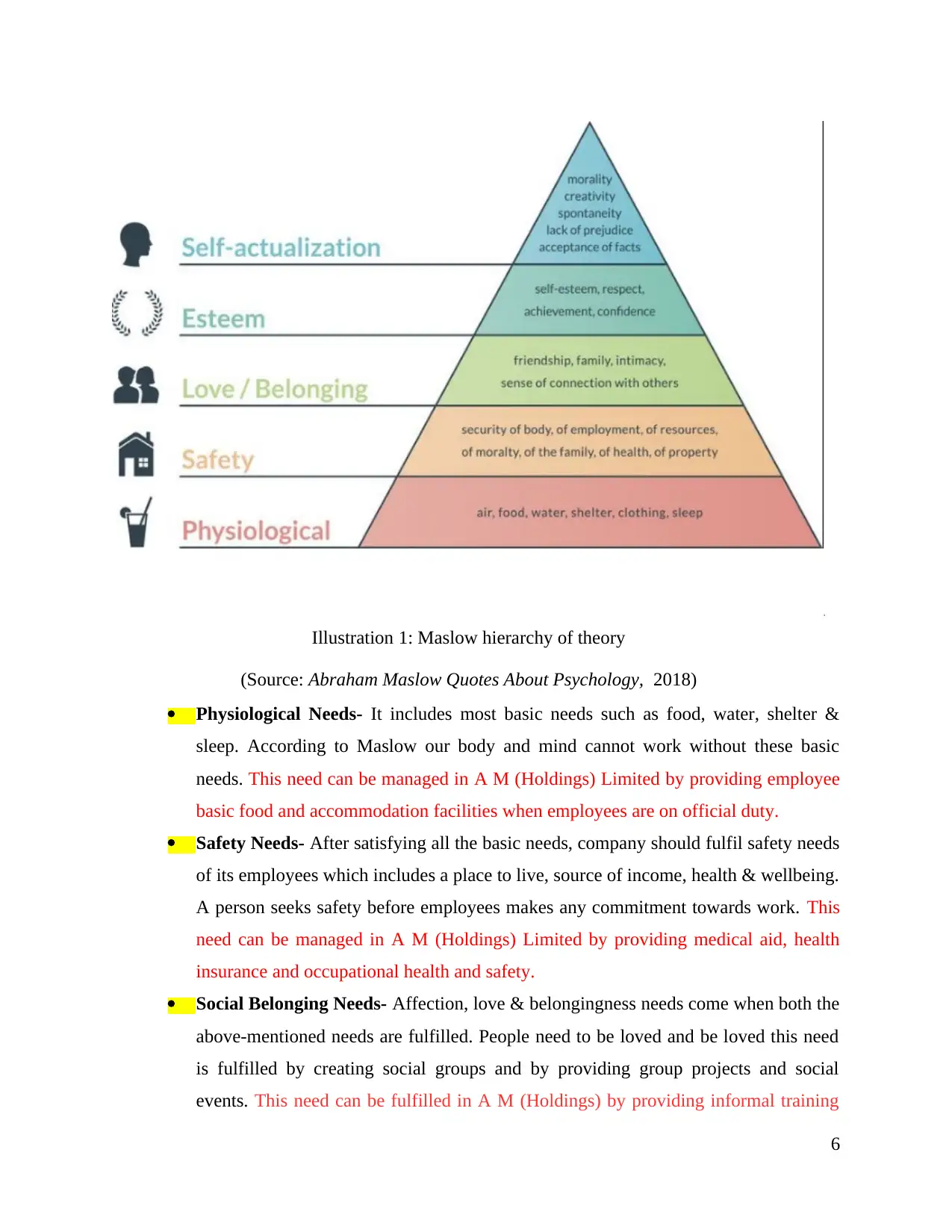
Illustration 1: Maslow hierarchy of theory
(Source: Abraham Maslow Quotes About Psychology, 2018)
Physiological Needs- It includes most basic needs such as food, water, shelter &
sleep. According to Maslow our body and mind cannot work without these basic
needs. This need can be managed in A M (Holdings) Limited by providing employee
basic food and accommodation facilities when employees are on official duty.
Safety Needs- After satisfying all the basic needs, company should fulfil safety needs
of its employees which includes a place to live, source of income, health & wellbeing.
A person seeks safety before employees makes any commitment towards work. This
need can be managed in A M (Holdings) Limited by providing medical aid, health
insurance and occupational health and safety.
Social Belonging Needs- Affection, love & belongingness needs come when both the
above-mentioned needs are fulfilled. People need to be loved and be loved this need
is fulfilled by creating social groups and by providing group projects and social
events. This need can be fulfilled in A M (Holdings) by providing informal training
6
(Source: Abraham Maslow Quotes About Psychology, 2018)
Physiological Needs- It includes most basic needs such as food, water, shelter &
sleep. According to Maslow our body and mind cannot work without these basic
needs. This need can be managed in A M (Holdings) Limited by providing employee
basic food and accommodation facilities when employees are on official duty.
Safety Needs- After satisfying all the basic needs, company should fulfil safety needs
of its employees which includes a place to live, source of income, health & wellbeing.
A person seeks safety before employees makes any commitment towards work. This
need can be managed in A M (Holdings) Limited by providing medical aid, health
insurance and occupational health and safety.
Social Belonging Needs- Affection, love & belongingness needs come when both the
above-mentioned needs are fulfilled. People need to be loved and be loved this need
is fulfilled by creating social groups and by providing group projects and social
events. This need can be fulfilled in A M (Holdings) by providing informal training
6
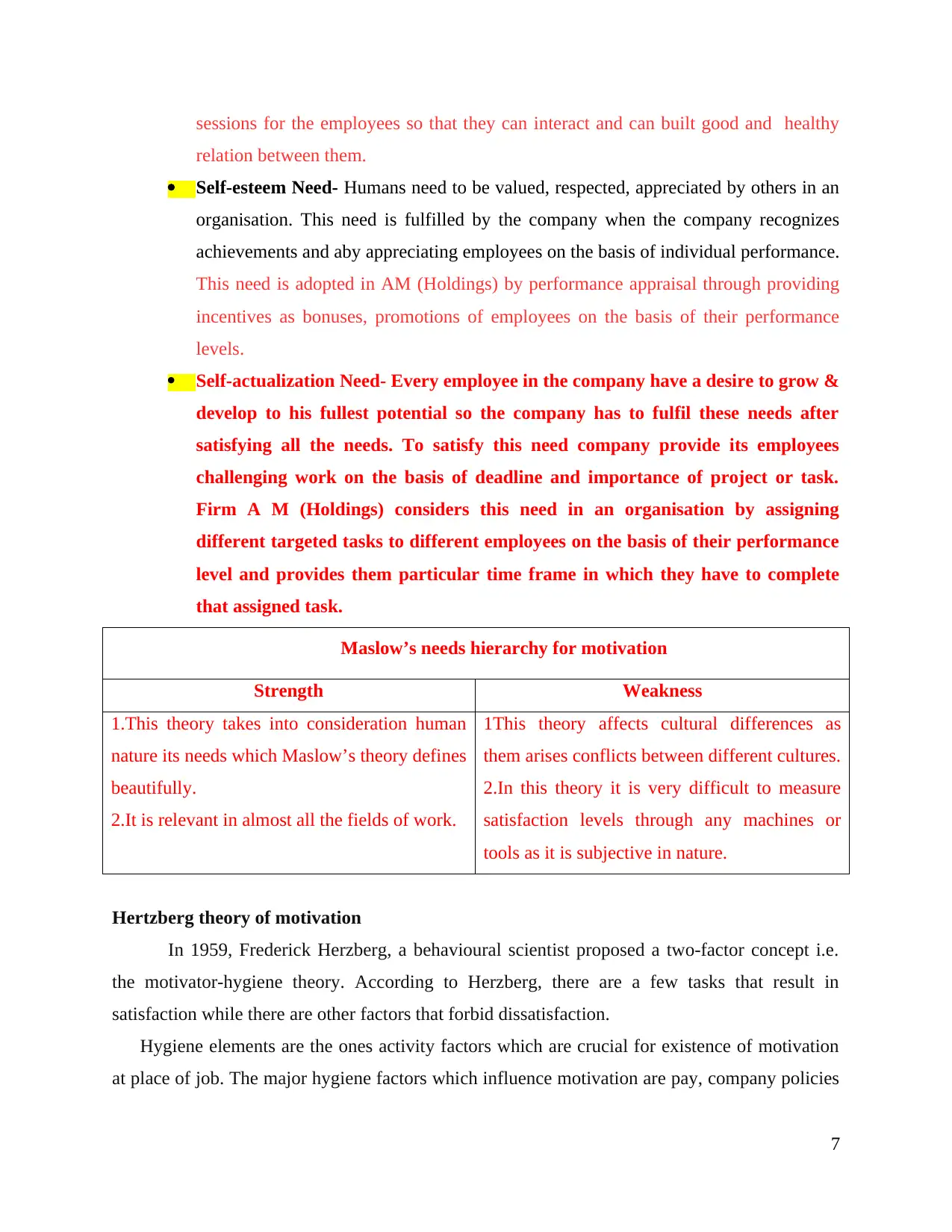
sessions for the employees so that they can interact and can built good and healthy
relation between them.
Self-esteem Need- Humans need to be valued, respected, appreciated by others in an
organisation. This need is fulfilled by the company when the company recognizes
achievements and aby appreciating employees on the basis of individual performance.
This need is adopted in AM (Holdings) by performance appraisal through providing
incentives as bonuses, promotions of employees on the basis of their performance
levels.
Self-actualization Need- Every employee in the company have a desire to grow &
develop to his fullest potential so the company has to fulfil these needs after
satisfying all the needs. To satisfy this need company provide its employees
challenging work on the basis of deadline and importance of project or task.
Firm A M (Holdings) considers this need in an organisation by assigning
different targeted tasks to different employees on the basis of their performance
level and provides them particular time frame in which they have to complete
that assigned task.
Maslow’s needs hierarchy for motivation
Strength Weakness
1.This theory takes into consideration human
nature its needs which Maslow’s theory defines
beautifully.
2.It is relevant in almost all the fields of work.
1This theory affects cultural differences as
them arises conflicts between different cultures.
2.In this theory it is very difficult to measure
satisfaction levels through any machines or
tools as it is subjective in nature.
Hertzberg theory of motivation
In 1959, Frederick Herzberg, a behavioural scientist proposed a two-factor concept i.e.
the motivator-hygiene theory. According to Herzberg, there are a few tasks that result in
satisfaction while there are other factors that forbid dissatisfaction.
Hygiene elements are the ones activity factors which are crucial for existence of motivation
at place of job. The major hygiene factors which influence motivation are pay, company policies
7
relation between them.
Self-esteem Need- Humans need to be valued, respected, appreciated by others in an
organisation. This need is fulfilled by the company when the company recognizes
achievements and aby appreciating employees on the basis of individual performance.
This need is adopted in AM (Holdings) by performance appraisal through providing
incentives as bonuses, promotions of employees on the basis of their performance
levels.
Self-actualization Need- Every employee in the company have a desire to grow &
develop to his fullest potential so the company has to fulfil these needs after
satisfying all the needs. To satisfy this need company provide its employees
challenging work on the basis of deadline and importance of project or task.
Firm A M (Holdings) considers this need in an organisation by assigning
different targeted tasks to different employees on the basis of their performance
level and provides them particular time frame in which they have to complete
that assigned task.
Maslow’s needs hierarchy for motivation
Strength Weakness
1.This theory takes into consideration human
nature its needs which Maslow’s theory defines
beautifully.
2.It is relevant in almost all the fields of work.
1This theory affects cultural differences as
them arises conflicts between different cultures.
2.In this theory it is very difficult to measure
satisfaction levels through any machines or
tools as it is subjective in nature.
Hertzberg theory of motivation
In 1959, Frederick Herzberg, a behavioural scientist proposed a two-factor concept i.e.
the motivator-hygiene theory. According to Herzberg, there are a few tasks that result in
satisfaction while there are other factors that forbid dissatisfaction.
Hygiene elements are the ones activity factors which are crucial for existence of motivation
at place of job. The major hygiene factors which influence motivation are pay, company policies
7
⊘ This is a preview!⊘
Do you want full access?
Subscribe today to unlock all pages.

Trusted by 1+ million students worldwide
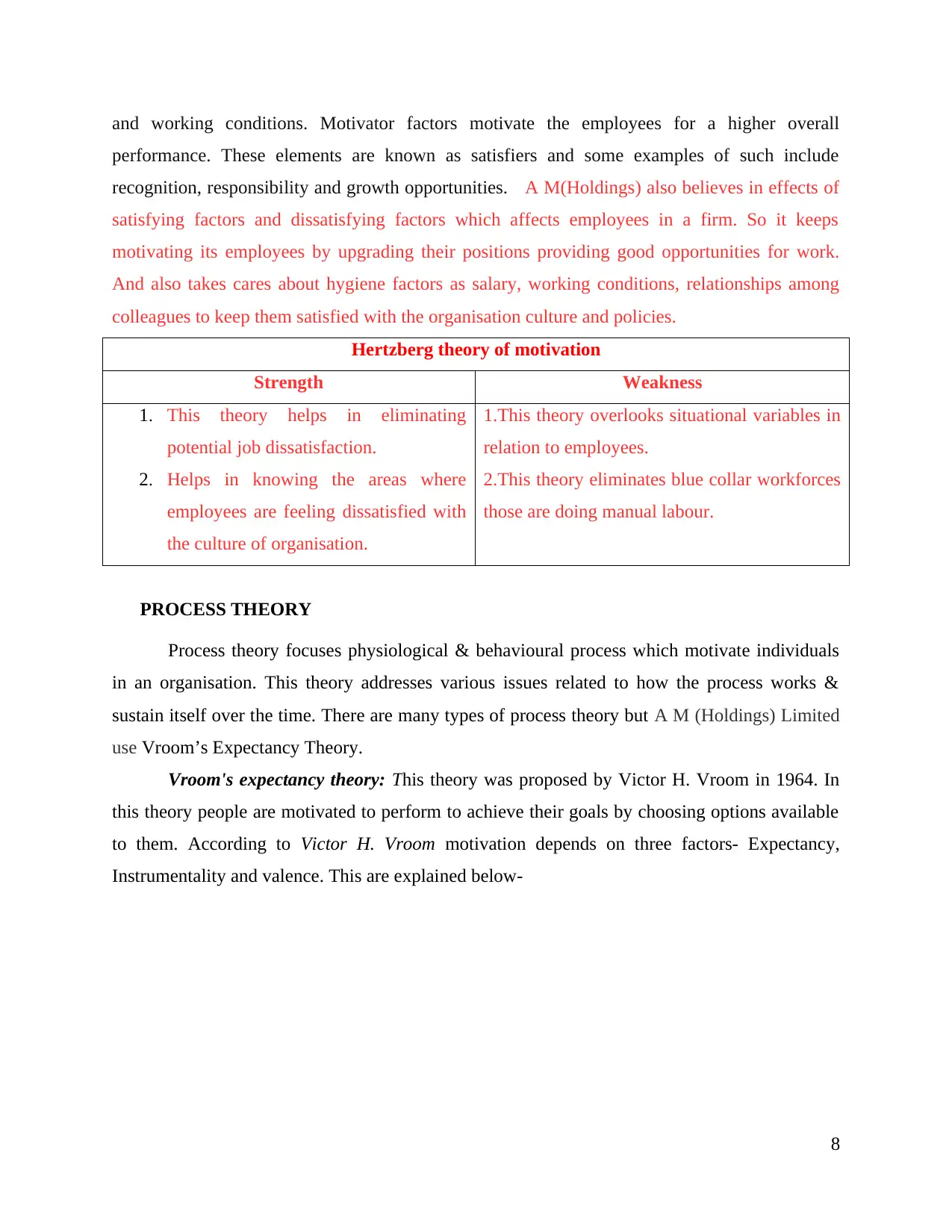
and working conditions. Motivator factors motivate the employees for a higher overall
performance. These elements are known as satisfiers and some examples of such include
recognition, responsibility and growth opportunities. A M(Holdings) also believes in effects of
satisfying factors and dissatisfying factors which affects employees in a firm. So it keeps
motivating its employees by upgrading their positions providing good opportunities for work.
And also takes cares about hygiene factors as salary, working conditions, relationships among
colleagues to keep them satisfied with the organisation culture and policies.
Hertzberg theory of motivation
Strength Weakness
1. This theory helps in eliminating
potential job dissatisfaction.
2. Helps in knowing the areas where
employees are feeling dissatisfied with
the culture of organisation.
1.This theory overlooks situational variables in
relation to employees.
2.This theory eliminates blue collar workforces
those are doing manual labour.
PROCESS THEORY
Process theory focuses physiological & behavioural process which motivate individuals
in an organisation. This theory addresses various issues related to how the process works &
sustain itself over the time. There are many types of process theory but A M (Holdings) Limited
use Vroom’s Expectancy Theory.
Vroom's expectancy theory: This theory was proposed by Victor H. Vroom in 1964. In
this theory people are motivated to perform to achieve their goals by choosing options available
to them. According to Victor H. Vroom motivation depends on three factors- Expectancy,
Instrumentality and valence. This are explained below-
8
performance. These elements are known as satisfiers and some examples of such include
recognition, responsibility and growth opportunities. A M(Holdings) also believes in effects of
satisfying factors and dissatisfying factors which affects employees in a firm. So it keeps
motivating its employees by upgrading their positions providing good opportunities for work.
And also takes cares about hygiene factors as salary, working conditions, relationships among
colleagues to keep them satisfied with the organisation culture and policies.
Hertzberg theory of motivation
Strength Weakness
1. This theory helps in eliminating
potential job dissatisfaction.
2. Helps in knowing the areas where
employees are feeling dissatisfied with
the culture of organisation.
1.This theory overlooks situational variables in
relation to employees.
2.This theory eliminates blue collar workforces
those are doing manual labour.
PROCESS THEORY
Process theory focuses physiological & behavioural process which motivate individuals
in an organisation. This theory addresses various issues related to how the process works &
sustain itself over the time. There are many types of process theory but A M (Holdings) Limited
use Vroom’s Expectancy Theory.
Vroom's expectancy theory: This theory was proposed by Victor H. Vroom in 1964. In
this theory people are motivated to perform to achieve their goals by choosing options available
to them. According to Victor H. Vroom motivation depends on three factors- Expectancy,
Instrumentality and valence. This are explained below-
8
Paraphrase This Document
Need a fresh take? Get an instant paraphrase of this document with our AI Paraphraser
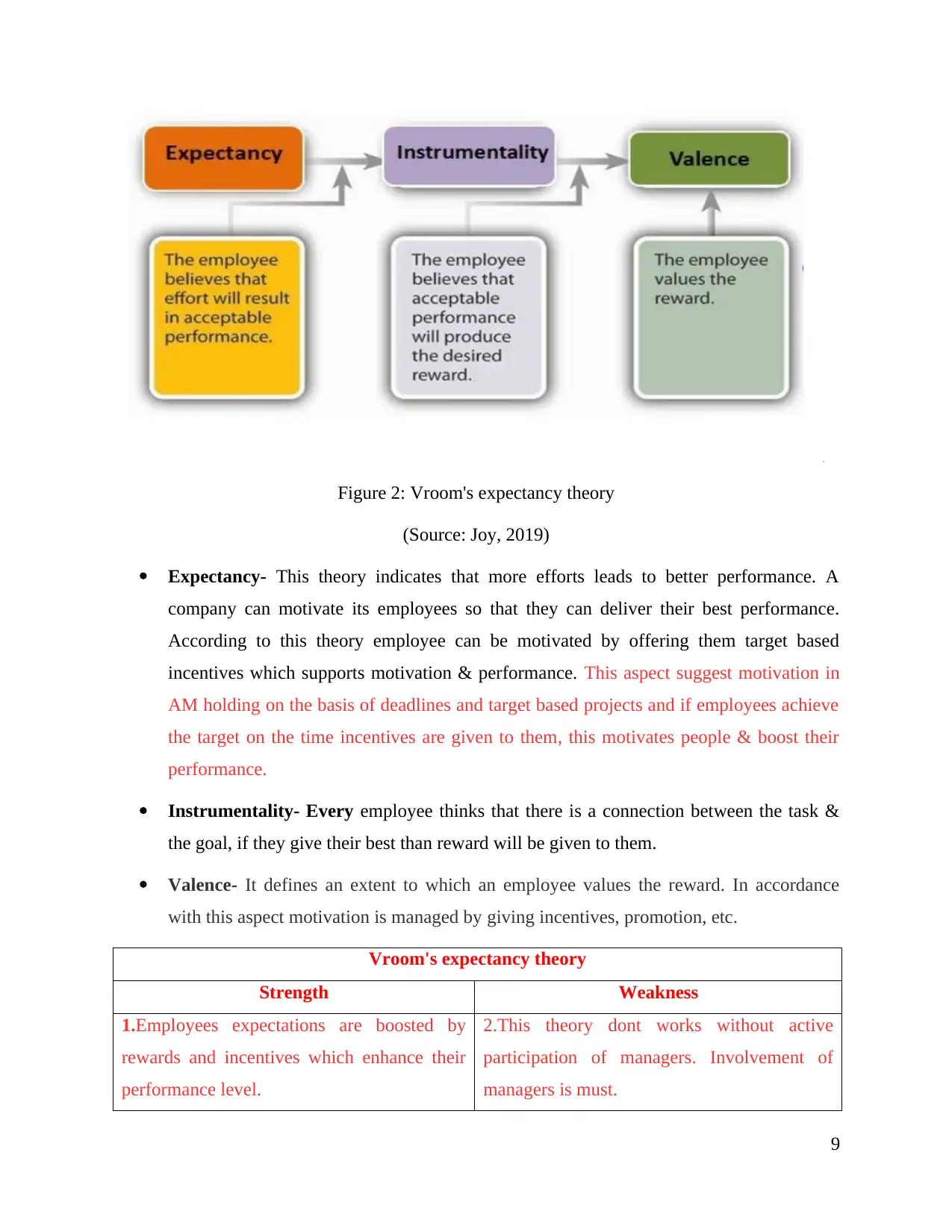
Figure 2: Vroom's expectancy theory
(Source: Joy, 2019)
Expectancy- This theory indicates that more efforts leads to better performance. A
company can motivate its employees so that they can deliver their best performance.
According to this theory employee can be motivated by offering them target based
incentives which supports motivation & performance. This aspect suggest motivation in
AM holding on the basis of deadlines and target based projects and if employees achieve
the target on the time incentives are given to them, this motivates people & boost their
performance.
Instrumentality- Every employee thinks that there is a connection between the task &
the goal, if they give their best than reward will be given to them.
Valence- It defines an extent to which an employee values the reward. In accordance
with this aspect motivation is managed by giving incentives, promotion, etc.
Vroom's expectancy theory
Strength Weakness
1.Employees expectations are boosted by
rewards and incentives which enhance their
performance level.
2.This theory dont works without active
participation of managers. Involvement of
managers is must.
9
(Source: Joy, 2019)
Expectancy- This theory indicates that more efforts leads to better performance. A
company can motivate its employees so that they can deliver their best performance.
According to this theory employee can be motivated by offering them target based
incentives which supports motivation & performance. This aspect suggest motivation in
AM holding on the basis of deadlines and target based projects and if employees achieve
the target on the time incentives are given to them, this motivates people & boost their
performance.
Instrumentality- Every employee thinks that there is a connection between the task &
the goal, if they give their best than reward will be given to them.
Valence- It defines an extent to which an employee values the reward. In accordance
with this aspect motivation is managed by giving incentives, promotion, etc.
Vroom's expectancy theory
Strength Weakness
1.Employees expectations are boosted by
rewards and incentives which enhance their
performance level.
2.This theory dont works without active
participation of managers. Involvement of
managers is must.
9
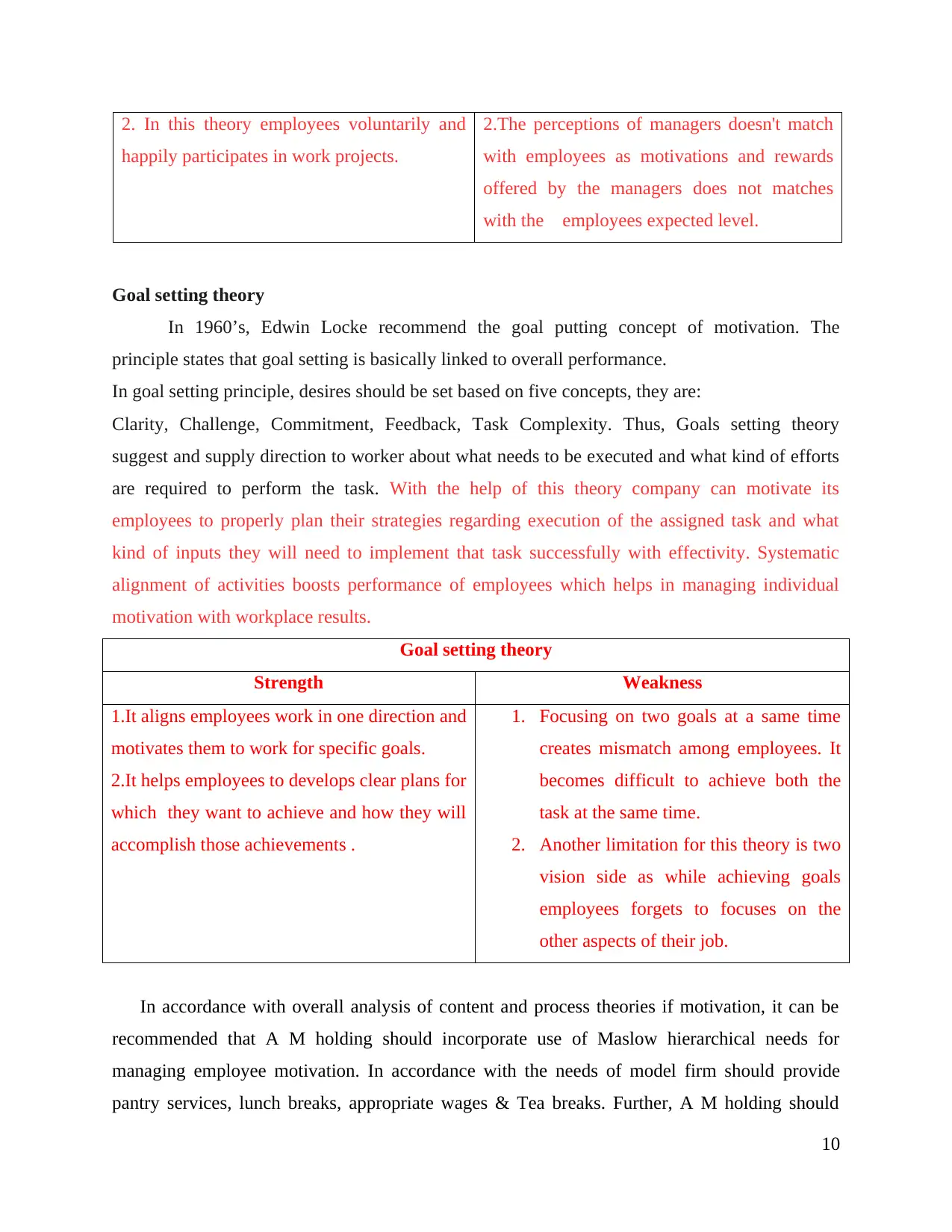
2. In this theory employees voluntarily and
happily participates in work projects.
2.The perceptions of managers doesn't match
with employees as motivations and rewards
offered by the managers does not matches
with the employees expected level.
Goal setting theory
In 1960’s, Edwin Locke recommend the goal putting concept of motivation. The
principle states that goal setting is basically linked to overall performance.
In goal setting principle, desires should be set based on five concepts, they are:
Clarity, Challenge, Commitment, Feedback, Task Complexity. Thus, Goals setting theory
suggest and supply direction to worker about what needs to be executed and what kind of efforts
are required to perform the task. With the help of this theory company can motivate its
employees to properly plan their strategies regarding execution of the assigned task and what
kind of inputs they will need to implement that task successfully with effectivity. Systematic
alignment of activities boosts performance of employees which helps in managing individual
motivation with workplace results.
Goal setting theory
Strength Weakness
1.It aligns employees work in one direction and
motivates them to work for specific goals.
2.It helps employees to develops clear plans for
which they want to achieve and how they will
accomplish those achievements .
1. Focusing on two goals at a same time
creates mismatch among employees. It
becomes difficult to achieve both the
task at the same time.
2. Another limitation for this theory is two
vision side as while achieving goals
employees forgets to focuses on the
other aspects of their job.
In accordance with overall analysis of content and process theories if motivation, it can be
recommended that A M holding should incorporate use of Maslow hierarchical needs for
managing employee motivation. In accordance with the needs of model firm should provide
pantry services, lunch breaks, appropriate wages & Tea breaks. Further, A M holding should
10
happily participates in work projects.
2.The perceptions of managers doesn't match
with employees as motivations and rewards
offered by the managers does not matches
with the employees expected level.
Goal setting theory
In 1960’s, Edwin Locke recommend the goal putting concept of motivation. The
principle states that goal setting is basically linked to overall performance.
In goal setting principle, desires should be set based on five concepts, they are:
Clarity, Challenge, Commitment, Feedback, Task Complexity. Thus, Goals setting theory
suggest and supply direction to worker about what needs to be executed and what kind of efforts
are required to perform the task. With the help of this theory company can motivate its
employees to properly plan their strategies regarding execution of the assigned task and what
kind of inputs they will need to implement that task successfully with effectivity. Systematic
alignment of activities boosts performance of employees which helps in managing individual
motivation with workplace results.
Goal setting theory
Strength Weakness
1.It aligns employees work in one direction and
motivates them to work for specific goals.
2.It helps employees to develops clear plans for
which they want to achieve and how they will
accomplish those achievements .
1. Focusing on two goals at a same time
creates mismatch among employees. It
becomes difficult to achieve both the
task at the same time.
2. Another limitation for this theory is two
vision side as while achieving goals
employees forgets to focuses on the
other aspects of their job.
In accordance with overall analysis of content and process theories if motivation, it can be
recommended that A M holding should incorporate use of Maslow hierarchical needs for
managing employee motivation. In accordance with the needs of model firm should provide
pantry services, lunch breaks, appropriate wages & Tea breaks. Further, A M holding should
10
⊘ This is a preview!⊘
Do you want full access?
Subscribe today to unlock all pages.

Trusted by 1+ million students worldwide
1 out of 22
Related Documents
Your All-in-One AI-Powered Toolkit for Academic Success.
+13062052269
info@desklib.com
Available 24*7 on WhatsApp / Email
![[object Object]](/_next/static/media/star-bottom.7253800d.svg)
Unlock your academic potential
Copyright © 2020–2025 A2Z Services. All Rights Reserved. Developed and managed by ZUCOL.





